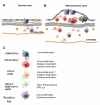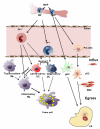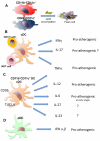How dendritic cells shape atherosclerosis
- PMID: 21835696
- PMCID: PMC3442786
- DOI: 10.1016/j.it.2011.07.001
How dendritic cells shape atherosclerosis
Abstract
Atherosclerosis is an inflammatory disease of the arteries, which results in major morbidity and mortality. Immune cells initiate and sustain local inflammation. Here, we focus on how dendritic cell (DC)-mediated processes might be relevant to atherosclerosis. Although only small numbers of DCs are detected in healthy arteries, these numbers dramatically increase during atherosclerosis development. In the earliest fatty streaks, DCs are found next to the vascular endothelium. During plaque growth, new DCs are actively recruited, and their egress from the vessel wall is dampened. In the adventitia next to mature atherosclerotic lesions, tertiary lymphoid organs develop, which also contain DCs. Thus, DCs probably participate in all stages of atherosclerosis from fatty streaks to mature lesions.
Copyright © 2011 Elsevier Ltd. All rights reserved.
Figures



References
-
- Andersson J, et al. Adaptive immunity and atherosclerosis. Clin Immunol. 2010;134:33–46. - PubMed
-
- Steinman RM, Hemmi H. Dendritic cells: translating innate to adaptive immunity. Curr Top Microbiol Immunol. 2006;311:17–58. - PubMed
-
- Banchereau J, et al. Immunobiology of dendritic cells. Annu Rev Immunol. 2000;18:767–811. - PubMed
Publication types
MeSH terms
Grants and funding
LinkOut - more resources
Full Text Sources
Medical

